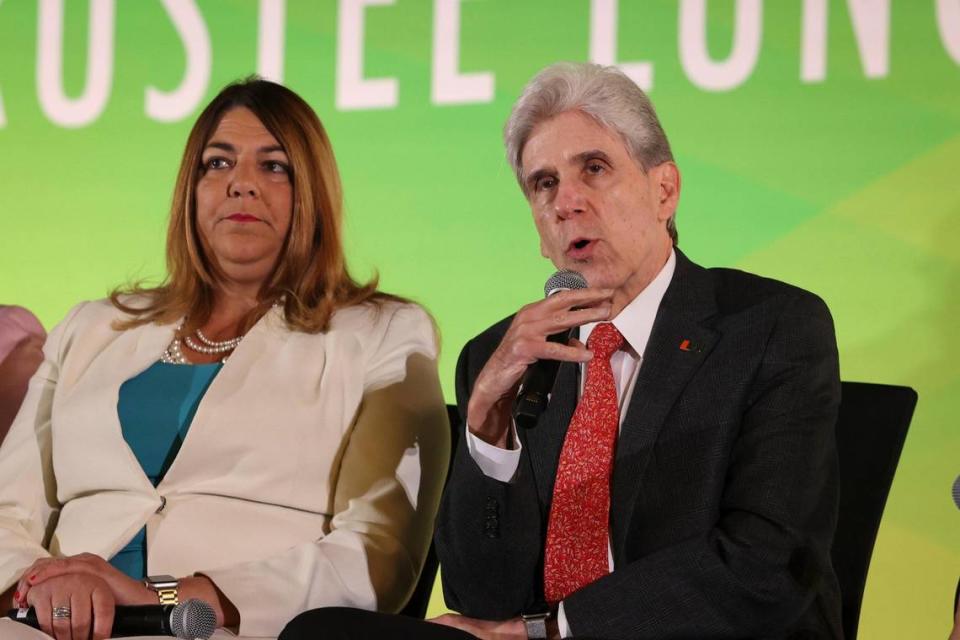University of Miami joins elite group of North America’s top research institutions
The University of Miami joined an invitation-only group of North America’s elite research universities on Thursday, accomplishing a decade-old goal and receiving one of the most prestigious honors in higher education.
The Association of American Universities invited UM this year to become a member following a unanimous vote by the association’s member institutions, a select group that includes Ivy League schools like Harvard and Yale, and top state universities, such as the University of Florida.
Five other universities, including the University of South Florida, also joined the AAU as new members.
The recognition boosts UM’s reputation worldwide, and could attract more staff, faculty and students to the university.
“This should be a point of pride not only for the university, but for our entire city and region. It is a sign of Miami’s growing preeminence,” said University of Miami President Julio Frenk in an interview.
AAU membership will also allow UM to network with other top leaders in meetings and working groups.
Frenk said he looks forward to improving UM by talking to his counterparts about how to tackle challenges like increasing student access, dealing with the student debt crisis and enhancing research. Through those discussions, the institutions can also take action together to fix the problems, he said.
Universities can’t apply to enter the AAU. Instead, current members judge prospective ones on set criteria, like the quality of education programs and the amount of competitive research financing, as well as faculty publications, awards and memberships in the national academies.

Only 3% of four-year institutions in the country belong to the AAU, Frenk said, and those members issue two-thirds of all PhD degrees in the U.S.
Because of the complex membership process, the AAU, founded in 1900, issues invitations sparingly. The last time the AAU invited a school was Tufts University in 2021. Prior to that, the AAU had invited just seven new members in 20 years.
“We are very proud to have these six distinguished universities from across the United States join AAU,” association President Barbara R. Snyder said in a press release. “We look forward to working with all of these universities to continue advancing higher education and laying the scientific foundation that helps keep our economy strong and our nation healthy and safe.”
Also joining the AAU this year as new members: Arizona State University; the George Washington University; the University of California, Riverside; and the University of Notre Dame.
The additions bring the total number of AAU members to 71 — a number that includes 69 universities in the U.S. and two in Canada. A majority are public institutions. Each member pays an annual membership fee of $153,000, according to Pedro Ribeiro, an AAU spokesman.
How did UM get invited to the AAU
Frenk described the AAU membership as a strategic goal of UM’s for at least a decade.
“You are subject to very rigorous metrics,” Frenk said. “And then in order to be invited, a unanimous vote from all of the members is required.”
He credited UM’s fourth president, Edward T. Foote II, for launching UM down the path to AAU membership. He said the university crossed this milestone because Foote limited student enrollment in the 1990s and prioritized research.
Foote’s successor, Donna Shalala, kept AAU membership as a key goal. And when Frenk arrived, he said he “endorsed the aspiration,” which he described as the “gold standard of higher education in the United States and around the world.”
Frenk pointed to some of UM’s research initiatives as factors that triggered the AAU invitation, including discoveries from the Rosenstiel School of Marine, Atmospheric, and Earth Science; the Leonard M. Miller School of Medicine and UHealth; and UM’s Climate Resilience Academy, a collaborative group from all of UM’s 12 schools and colleges to combat climate change impacts.
Sixteen researchers affiliated with UM have earned membership to the National Academies of Science, Engineering, and Medicine. Frenk himself is a part of the National Academies of Science and Medicine.
In the 2022 fiscal year, UM’s research and sponsored program expenditures totaled more than $413 million.
After induction, universities must maintain the standards or risk expulsion. In 2011, for the for the first time in its 111-year history, the AAU ousted a member, the University of Nebraska at Lincoln, according to the New York Times.


